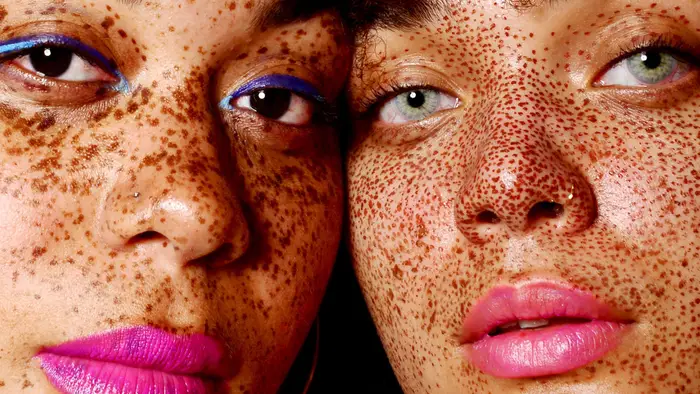What are freckles?
Freckles are small brown spots on your skin, often in areas that get sun exposure. In most cases, freckles are harmless. They form as a result of overproduction of melanin, which is responsible for skin and hair color (pigmentation). Overall, freckles come from ultraviolet (UV) radiation stimulation.
There are two categories of freckles: ephelides and solar lentigines. Ephelides are the common type most people think of as freckles. Solar lentigines are dark patches of skin that develop during adulthood. This includes freckles, aging spots, and sunspots. The two types of freckles can look similar but differ in other ways such as their development.


How do you get freckles?
Ephelides: These freckles form as a result of sun exposure and sunburns. They can appear on anyone who doesn’t protect themselves from UV rays. They show up on your face, the back of your hands, and upper body. This type tends to be most common amongst people with lighter skin tones and hair color. People of Caucasian and Asian descent are more prone to ephelides.
Solar letigines: Like ephelides, this type tends to appear in Caucasians and adults over 40 years old.
What increases your chance for freckles?
The credit for freckles goes to both the natural environment and genetics. Your risk for burning can increase the incidence of freckles.
In a studyTrusted Source of 523 middle-aged French women, two elements predicted the presence of freckles: frequent sunburns and a gene known as MC1R, which provides instructions for making melanin. But the gene doesn’t affect all individuals the same way. There are two type of melanin: pheomelanin and eumelanin.
Can I prevent more freckles from appearing?
For people who want to avoid freckles, prevention is key. It’s also possible to prevent freckles while speeding up their disappearance. The American Academy of Dermatology recommends using a water-resistant sunscreen with an SPF of at least 30 on your skin. Wait 15 minutes before heading outdoors for full protection. Do this every day, even in the winter, to prevent further pigmentation.
“You really can’t freckle unless you’ve had sun exposure,” explains Dee Anna Glaser, MD, chair of the department of dermatology at St. Louis University. “Even if you inherit that tendency, if your mom and dad were the most amazing sunscreen advocates and kept you out of the sun, you probably still wouldn’t freckle.”
Nirav SKIN & HAIR CLINIC
Address : A-66, Rangavadhut Society, Ishwarkrupa Rd, Near Bombay Market, Matawadi, Surat, Gujarat 395006.
Monday to saturday morning 9:30am to 1 pm
evening 5pm to 8.30 pm
Address : 114, Mildstone canal point, Near INS hospital, Khatodra Wadi, Surat, Gujarat 395002.
Monday ,Wednesday, Friday 2pm to 3.30pm
Phone : 098799 05850
Email : [email protected]
© Copyright 2022 Nirav Skin & Hair Clinic. All Rights Reserved Designed and maintained by Creative Kshetra

